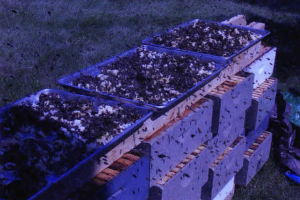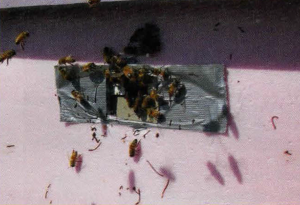By: Ed Simon
This article originally appeared in the Summer 2016 issue of BEEKeeping Your First Three Years
The conventional wisdom about beekeeping is that there are no pat answers. Whatever works for you is the right way for you to do something. Of course, most beekeepers are never satisfied and are sure there is always a better way of accomplishing a task or solving a problem. Consequently, if you ask five beekeepers the best way to accomplish something you get seven or more answers. None are wrong they just different, they are what works for that beekeeper at that particular time. Here is a collection of hints that may help you in your beekeeping endeavor.
Ants – They will find an easy meal.
Cinnamon sprinkled around the feeder rim and on the inner cover takes care of the ant problem. (Most of the time)
Attaching Wild Comb – Attaching to a frame.
After you have collected a wild colony and need to attach the wild comb to a frame, be sure to keep the top at the top. Comb cells have a definite slope to them. The outer edge of the cell is higher than the bottom of the cell. When you attach comb to your frame be sure you keep the top at the top.
Cows/Horses – Hives make good scratching posts.
Cows are curious and like to scratch themselves. A bee hive is just about the right height. Unfortunately they are not very stable when a 1200 pound cow has an itchy butt. Horses also like to scratch. If your hives are in a pasture or where a farmer may release cattle into the area then string an electric fence up to keep them away from the hives. Usually the farmer will let you tap into their electric fence to power your hive fence.
Crystallized Honey – Mix it up.
Creamed honey is honey that has been forced to crystallize in a controlled state. When starting a new batch, incorporating it into the liquid honey can be a tiring process. Instead of mixing a couple of pounds of starter culture into 40 or 50 pounds of honey, start be mixing it into a small amount of honey (4 to 5 lbs.) until it’s thoroughly mixed with no lumps. Then add the small amount to the larger amount.
Which way to use an Entrance Reducer -Openings up.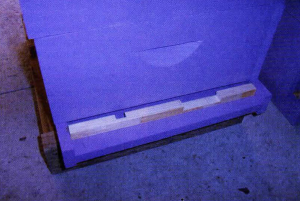
When installing a wooden entrance reducer, make sure the opening is up. That way the entrance will be least likely to get clogged with dead bees and debris. This is very important when closing the hives up for the Winter.
Entrance Reducer – They never fit correctly.
When building a wooden entrance reducer, make sure the entrance reducer is smaller than the smallest opening you have on a bottom board. Then use a wad of newspaper on one end to work as a Spring and force a tight fit of the reducer.
Extraction Clean Up – Let the bees do the work.
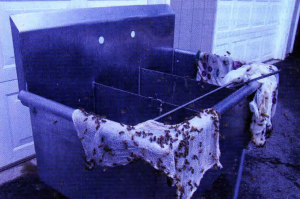 Extraction is a sticky mess and your helpers have a tendency to disappear when it’s clean up time. Move your equipment out of the extraction area and let it set for a couple of days. All the junk honey that you would normally wash away will be reused by your bees. Wipe up the thicker/deeper puddles of honey with a wet rag so the bees won’t drown and then hang the rags up for the bees to clean the honey off. Cover the equipment so if it rains the bees can still get to it but the rain can’t wash all the honey away.
Extraction is a sticky mess and your helpers have a tendency to disappear when it’s clean up time. Move your equipment out of the extraction area and let it set for a couple of days. All the junk honey that you would normally wash away will be reused by your bees. Wipe up the thicker/deeper puddles of honey with a wet rag so the bees won’t drown and then hang the rags up for the bees to clean the honey off. Cover the equipment so if it rains the bees can still get to it but the rain can’t wash all the honey away.
The removal of honey from capping is easily accomplished by spreading the capping wax out on a cookie sheet (I use commercial cookie sheets) and letting the bees reclaim the honey. It’s best to take them in at night as the raccoon also like the honey. As a side note, a five gallon bucket of moderately packed capping wax will yield about five pounds of cleaned wax.
Feeder Jar Holes – 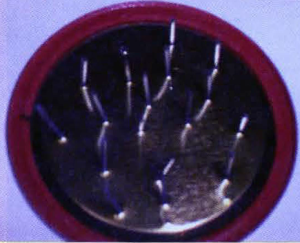
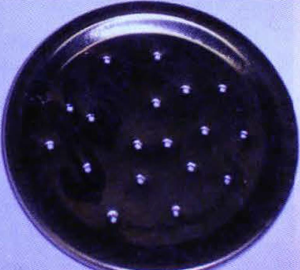 If they are too big they’ll leak syrup. When punching holes in a jar lid to make a jar feeders use a brad gun with 18-gauge brad. The 18-gauge brad is a nice convenient size for a feeder hole. The brad gun allows for making quick and non-finger smashing hole. Place the jar lid on a soft surface like a piece of insulating foam, so the brads won’t nail the lid to the workbench. Removal of the brads is then quite easy. If the holes are to big then use a nail and hammer and put the lid on something solid so just the tip of the nail penetrate the lid.
If they are too big they’ll leak syrup. When punching holes in a jar lid to make a jar feeders use a brad gun with 18-gauge brad. The 18-gauge brad is a nice convenient size for a feeder hole. The brad gun allows for making quick and non-finger smashing hole. Place the jar lid on a soft surface like a piece of insulating foam, so the brads won’t nail the lid to the workbench. Removal of the brads is then quite easy. If the holes are to big then use a nail and hammer and put the lid on something solid so just the tip of the nail penetrate the lid.
Frame Feeder – Bees will drown or get stuck in honey.
When using the one or two gallon frame feeders or division feeders that sit inside a super, add straw before filling the feeder. The straw provides a foot hold for the bees. It will allow them to escape if they get stuck in the syrup. The straw has to come to the top of the syrup.
Hive Air Flow – A stick will do it.
Placing a stick or a piece of wood between the inner cover and the top cover will allow a better flow of hot air from the hive during the Summer months.
Hive Placement – Do not place your hives in straight rows.
If hives are placed in a row, the end hives will eventually have more bees. If you have your hives in a row, your bees will tend to drift to the hives at the ends. Place your hives at irregular distances and at angles to one another. This past year I was standing by the end hive in a row. Within 30 seconds there were bees returning to me – not to the hive.
Hive Placement – Not in a damp valley.
Hives should not be placed in an area where there is a lot of fog or the possibility of a creek overflowing. A friend looked out his kitchen window one morning and saw the bottom brood box of one of his hives under water. Not a good thing to see first thing in the morning. It makes for a bad day.
Honey Storage – Five gallon pails – Do NOT use pails that previously stored dill pickles.
Five gallon pails are a very easy to use and a great way to store honey. If you fill them full they weigh about sixty pounds. Before placing the lid on make sure the rubber gasket is in place. Then put a piece of food storage plastic (Saran Wrap) over the top before sealing the pail. This will keep the honey off the top of the pail when you move it. It is also easier to scrape clean than the lid of the pail. Sixty pounds is a lot of weight for the more mature (politically correct) person. Each pound of honey weighs about 12 pounds. Reducing the volume to four gallons can make lifting the pails a lot easier.
As was noted at a bee club meeting, when selecting pails for honey storage do not and I repeat do NOT, NOT, NOT use pails that were used to store dill pickles.
Hive Stand – Keep your stands low.
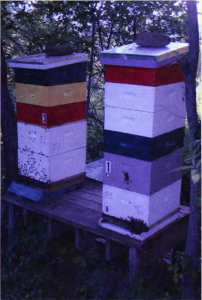 Be careful when placing your hive stands. Think about the following items.
Be careful when placing your hive stands. Think about the following items.
The higher your hives, the higher your supers are when you want to remove them. When full they weigh about 50 pounds each. You do not want to climb a ladder to retrieve a super.
Hive Stand – Make sure your hive stands have a solid base.
Spend the extra time to insure your hive stands are on a solid/level base. You don’t want them to tip over as you add hive bodies and supers.
Honey Wax Removal – Wax floats on honey.
After extracting is finished and your new honey has sat for a while, the wax and other debris will float to the top. To remove this scum, use a piece of plastic food wrap. Lay it on the surface of the honey and pat it down gently. When you carefully remove it, much of the wax and other debris will come off with it. I haven’t tried this yet but it sure sounds promising.
Inner Covers -The thick and thin of it.
Inner covers have a thick rim side and a thin rim side. The thick rim side faces the bees during the Winter. This allows the bees to navigate above the frames. The thin rim side faces the bees during the Summer. ln theory, the thin side is small enough to the bees won’t build comb between the frames and the inner cover.
Inner Covers – Why use them?
Inner covers allow the top cover to remain loose. The construction of the top cover with its dropped down sides would be very difficult to remove if it was glued down with propolis or comb. By using the inner cover you can remove the top cover with ease and the use a hive tool to un-stick the inner cover.
Installing Bee Packages – They will miss the hive.
Even though you wet down the bees before shaking your new package into the hive, they seem to miss where you want them to go and spill out over the sides of the hive. To eliminate some of this, use an empty hive body and place it on top of the target hive. Then keep the shipping box inside the top hive body while shaking the bees into the bottom box. This will help channel the bees into the lower hive box. You can then use your brush to force the bees clinging to the top box down to the hive.
Marking Queens – They have a tendency to fly away.
Bees have a tendency to move up and to the light. When marking a queen, use this trait. First convince your spouse that queens don’t sting. Then hint that the bathroom is an excellent work area. Next ensure her/him that if she escapes you can find her before the next shower.
Close the bathroom door, remove the curtains from the window and turn off all the lights. Then use the window sill as a workstation for the queen marking. From then on everything is fine.
Note: Unless you are concerned about the date/year of the queen, then yellow or white are easy colors to find. Red or green on a brown background is very difficult for a person that is red/green colorblind to see.
Note: Be sure to allow the marking to dry before releasing the queen.
Measurements – Keep them handy.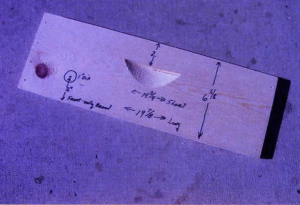
Keep a “Story Board” in your work room with all the measurement you need to build your equipment. Here is the one I have for super measurements. It hangs directly above my saw.
Mouse Excluder – Keep them out.
When you winterize your hives and you are unable to find any ¼ inch hardware cloth to use as a mouse excluder, cut up plastic queen excluder. Unfortunately it will also stop drones from leaving the hive. So when the workers drive the drones out they will be unable to exit the hive.
Mowing Grass – The bees really get upset.
It only takes one time of mowing the grass in front of the hives to convince you to not do that again. Unfortunately, your spouse (notice the gender nonspecific reference) requires the grass to be mowed.
Old shingles to the rescue – placing an old but serviceable tar paper shingle in front of the hive will at least allow you to not bump the hive when mowing. A normal shingle will normally suffice. If more depth is needed then really go overboard and use a second shingle. You will still have to mow the grass but you won’t have to get as close to the hives and possibly bump them with the mower.
A package of unmatched shingles is cheap at the local building supply store.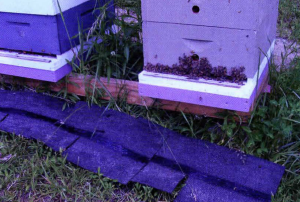
Nosema Dead Out – Bees can’t wait to go.
In the Spring and you found a have that has a severe case of Nosema, clean it out the best you can and it should be safe to use it. Then when you put bees in it, treat the syrup with fumagilin-B. Hopefully that will stop it from recurring while the bees clean up the rest.
Note: If the comb is over four or five years old, then it is best to replace it.
Paper Towels – Indispensable.
Cheap bulk paper towels that can be tossed away can save you an unbelievable amount of time compared to cleaning out cloth rags.
Painting – Extend the life of your wooden ware
When painting a group of woodenware, use a paint roller to apply the paint. Then smooth it out and work it in with a brush. The time saved in not dipping the brush can be significant.
Painting – Cheap rollers
Watch for sales on the cheap rollers. Buy the cheapest you can get and keep them bandy for when you need them. It’s easier to toss them in the trash than it is to clean them. A little fuzz on the hive does not stop the bees from using it.
Painting – Multiple coats of paint.
After using a roller to apply the first coat of paint to the woodenware, wrap the roller in a plastic bread bag. This will keep the paint on the roller from drying out and allow you to use the roller for the second coat.
Pasture Gates – They are there for a purpose.
If you have your hives on a farmer’s property, pay attention to the gate positions when going to the hives. If there are animals in the field, be sure to close the gates. If not, then make sure the gate is in the same position when you leave as it was when you got there. A loose animal will lose you your apiary privileges with that farmer (and all of his friends).
Removing Supers – Less sticky supers
The burr and cross comb you didn’t clean up has come back to haunt you. Even if you did keep things orderly the bees have a way of getting ahead of you. Besides it being a mess you lose honey. To help eliminate this problem, try this procedure.
The day before you remove the supers for extraction swap and reverse the supers on each hive.
Remove each super. Place then in order and all the fronts facing the same direction.
Reinstall the supers starting with the first removed. At the same time make sure the front of the next super is now above the back of the previous super. This placement maximizes the possibility that tom comb and runny honey will not be replaced back in the original position.
The bees will clean up all the loose honey by the next day and the removal should be a lot less sticky.
Swarms – It will happen – be prepared.
Be ready. Have an extra brood box or a nuc available to store the swarm. A cardboard box will do in a pinch. If you can, it also helps to have to prepared site to set the swarm. It doesn’t hurt to have an extra stand leveled and ready to go.
Skunks – They will find a good meal.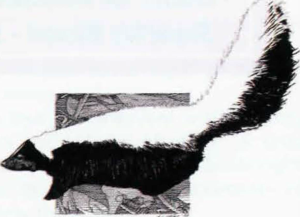
Carpet tack strips nailed to the bottom board will stop most skunks. Face the sharp tacks toward the opening.
After trapping and killing three skunks this year I finally gave up and installed the carpet tack strips. We still have a lot of skunks but I don’t have to strip in the garage before my wife will let me in the house.
Smoker Ash Disposal – Don’t start a fire.
Your smoker of ash residue could still be hot. Dump it into a metal bucket. Any still burning fuel can smolder safely without burning your barn down or catching your neighbor’s hay on fire. To extinguish the smoker and save some of the fuel, use a cork to smother the fire.
Smoker Cleaning – Your lid never goes on easily due to soot and creosote buildup.
Remove the bottom grate and clean. Don’t forget the holes in the bottom grate.
Burn it out – Use a MAP or propane torch to start the residual creosote afire. Then use a scraper or screwdriver to chip the rest away.
Use a wire brush to loosen the soot – After cleaning the big chunks out of the smoker, use a 3″ it 4″ wire brush on an electric drill to remove the remaining soot and creosote.
You’ll probably never get it completely clean but, at least you can put the top on easier.
Smoker Fuel – If it burns than you can probable use it as fuel.
 Everyone has their own favorite fuel. I use dried cow manure mixed with landscaping shredded wood and pine needles. The hard part is collecting the manure. You have to be fast with the smoker when the cow decides to void itself. A second method is to invade a pasture with a wagon and a shovel and get the not so fresh manure. After drying it out on the patio and chopping it into small pieces, store it in the ever present five gallon buckets. Other forms of fuel are: jeans, pine cones, pine needles, rags, sawdust, wood chips, Landscaping shredded wood and bark and anything else that burns. Try for something that is cheap and easy.
Everyone has their own favorite fuel. I use dried cow manure mixed with landscaping shredded wood and pine needles. The hard part is collecting the manure. You have to be fast with the smoker when the cow decides to void itself. A second method is to invade a pasture with a wagon and a shovel and get the not so fresh manure. After drying it out on the patio and chopping it into small pieces, store it in the ever present five gallon buckets. Other forms of fuel are: jeans, pine cones, pine needles, rags, sawdust, wood chips, Landscaping shredded wood and bark and anything else that burns. Try for something that is cheap and easy.
Smoker – Easy start.
Two easy ways of starting your smoker are by using a propane or map torch. If you are having trouble starting the smoker, give the fuel a squirt of hand sanitizer. Most sanitizers are about 66% alcohol and catch fire very easily.
Warning: Do NOT use anything that will explode.
Temperature Requirements – Thermometers get sticky.
One of the most used tool I have in my toolbox as an infrared thermometer with a laser. It will allow you to take the temperature of honey, wax or anything else without having to clean it afterwards. To take a temperature, you just aim it and pull the trigger. Three seconds later the temperature is displayed on a screen. No mess, no fuss.
Wax Cleanup 1 – Wax is almost impossible to remove completely. Use a paper towel and place it between the iron and your clothes with wax on it. Press the cloth through the paper towel. The towel will absorb the wax when it has melted. It may take a couple of passes to remove most of the wax.
Wax Cleanup 2 – A 300 – 500 degree Celsius (centigrade) heat gun and cheap paper towels will clean up the sticky wax. First remove as much wax as you can with a scraper. Then warm the wax a little bit with the heat gun. Use the scraper to remove more wax once it is loosened. As a final pass melt all the remaining wax with the heat gun and wipe it with a clean paper towel.
Heat guns are available at all hardware and lumber supply stores. A hair dryer will do in a pinch. But must hair dryers don’t get hot enough to heat the underlying metal or wood for an easy wax removal. They are also not built for continuous use. Spouses have a tendency to get upset when you ruin their hair dryer.
Wax Molds – How to form wax cakes.
Cheap and readably available wax molds are:
A. 1 oz. – Mini cupcake mold (look in the Salvation Army Store)
B. 1.5 oz. – ¼ cup – Cupcake baking pans (look in the Salvation Army Store)
C. 8 oz. – 1 cup – Butter containers.
D. 20 oz. – 2 cup – Small baking bread or meat loaf pans (look in the Salvation Army Store)
E. 52 oz. – 6 cup – Larger bread or meat loaf pans (look in the Salvation Army Store)
Be sure to use a releasing agent when forming wax cakes. After they cool you can usually pop them out.
Wax Moths – How to stop them.
Wax moths don’t seem to bother supers that are stored where it is freezing. I have kept my “DRY” and some “WET” supers in a barn with no problem. Of course it gets to 20 degrees below zero here in Minnesota.
Weight of Honey – A quick easy way to estimate the weight of honey.
Honey weight about 1.5 times the volume of the honey.
A gallon of water weighs about eight pounds. A gallon of honey weighs about twelve pounds.
Another conversion that is convenient is that honey weighs about 1.5 times the volume of water. A good example of this is the standard honey bear. It holds eight ounces of honey or water by volume. But it is considered a twelve ounce honey bear (by weight).
Weight of Boxes – A generalized weight for standard bee equipment:
| 55-60 lbs | Fully filled 9 frame medium super |
| 12-18 lbs | Wet 9 frame super (after extraction) |
| 90-100 lbs | Large 10 frame brood box |








